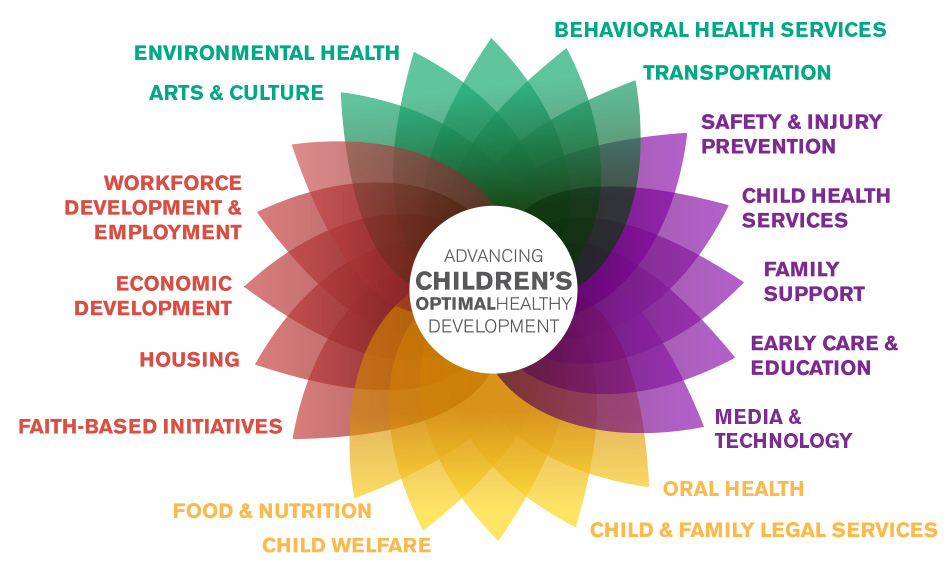At Connecticut Children's Office for Community Child Health (OCCH), we know that improving child health and well-being requires a comprehensive approach. The newly updated "flower diagram," which now includes Media & Technology, seamlessly represents this evolving reality. By addressing the many interconnected social determinants of health, OCCH’s 17 programs build a holistic support system for children and their families, working across sectors to tackle barriers to health, development, and opportunity.
The "All Sectors In" flower diagram is a framework for action and illustrates how multiple sectors contribute to advancing children’s healthy development. Each petal represents a vital area, from Housing and Economic Development to Family Support and Food & Nutrition. The overlapping petals remind us that health outcomes do not exist in isolation—progress in one area strengthens others. For example:
- A safe, stable housing environment improves a child’s physical health while reducing stress for parents.
- Access to food and nutrition ensures children are ready to learn and grow.
- Strong behavioral health services promote resilience and mental wellness, enabling children to thrive in school and life.
Now, with Media & Technology added to the framework, OCCH expands its perspective to deliver resources, strengthen community connections, and empower families.
The Intersect of Media, Technology, and Health
While there are many definitions, Media can be defined as the diverse ways in which people create and receive information – including but not limited to: news outlets, social media (i.e., Instagram, TikTok), print media, artifacts, and media designed to support entertainment or learning. Technology includes electronic devices, tools, and advanced systems – including but not limited to: computers, artificial intelligence, calculators, geospatial information systems, and cell phones.
The expansive ecosystem of media and technology is complexly impacting the health and well-being of children, youth, and the adults in their lives. Media and technology have the potential to be both a protective factor and a risk factor for developmental outcomes; for example, television shows and games guided by a social-emotional curriculum might teach young viewers new strategies for self-regulation. Modeling mindfulness or belly breathing through a character like Daniel Tiger might strengthen the social-emotional competence of children, a protective factor of child mental health.
On the other hand, the American Academy of Pediatrics cautions that “today's children are spending an average of seven hours a day on entertainment media, including televisions, computers, phones and other electronic devices,” a reality that the 2023 U.S. Surgeon General report expands on. The report, focused on how social media is impacting youth mental health specifically, asserts that “social media use by youth is nearly universal. Up to 95% of youth ages 13–17 report using a social media platform, with more than a third saying they use social media ‘almost constantly.’ Although age 13 is commonly the required minimum age used by social media platforms in the U.S., nearly 40% of children ages 8–12 use social media.”
Too often regarded as a black-or-white topic, there is an opportunity to better understand and explore how media and technology are contributing to the health of children, youth, and families across sectors. In the aforementioned examples, media and technology are connected to the following sectors labeled on the OCCH diagram alone: Behavioral Health Services, Arts and Culture, Family Support, Early Care and Education, and Injury Prevention. In fact, exploring how media and technology intersect with other sectors, such as supporting healthy and stable housing or promotion and education for healthy nutrition, among others, will continue to be one of the most pressing public health priorities of our time.
Examples of How OCCH Programs May Address Media & Technology
The infrastructure of OCCH is uniquely designed to address and explore how media and technology are impacting the health and development of children, youth, and families. Childhood Prosperity Lab (The Lab), for example, is a resource for changemakers who are designing, testing, and scaling social innovations – creative strategies, frameworks, and resources that support the health of children, youth and families where they live, learn, work, play and pray. Social innovations designed and informed by media and technology are no exception. In fact, six of the seven changemakers who participated in a Mastermind Session in 2024 leveraged technology as a platform for their innovation, and one changemaker specifically designed a social innovation through children’s media programming to strengthen social emotional learning.
OCCH's Injury Prevention Center (IPC) is also a promising initiative for addressing and promoting the safety of children and youth as it relates to media and technology use. In the recommendation section of the 2023 U.S. Surgeon General Report, Surgeon General Vivek explicitly calls on researchers, policymakers, caregivers, and children alike to steward this work in partnership with local coalitions and agencies. IPC has an infrastructure that can support this call to action; in addition to its existing focus areas, the core activities of IPC include: research, community outreach programs, education and training, and policy/advocacy. According to Jonathan Haidt, author of The Anxious Generation: How the Great Rewiring of Childhood is Causing an Epidemic of Mental Illness, “anxiety and its associated disorders seem to be the defining mental health illnesses of young people today.” Throughout the book, Haidt draws on developmental neuroscience, data from the U.S. Survey on Drug and Health, and other sources to describe how media and technology are changing human development, especially for children and youth who are undergoing critical periods. IPC may have the infrastructure, especially through its education and training core component, to support the mental health of children and youth in the Hartford community.
By embracing Media & Technology, OCCH is meeting families where they are, ensuring they have the tools and resources to navigate challenges, access opportunities, and achieve optimal health. Together, with all sectors working in harmony, we can create a brighter, healthier future for children and families in Connecticut and beyond.

